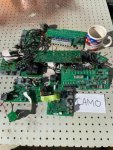papakb
Well-known member
- 2,285
- 1,196
- 113
- Location
- San Jose, Ca
I originally posted this as a reply on another posting and I don't think it was getting the visibility it needed. I think this would be an excellant forum to get this information out to the group so that we could possibly develope a decent final design. Lord knows, Uncle hasn't been able to! We've got some smart people here that have actually worked on these things and understand them better than some design engineer sitting at a desk somewhere.
My question is: what were the original designs (schematics) and how can we improve them or create a design that eliminates all the expensive options we now have?
Original post:
Speaking of schematics, has anyone ever come across real, full schematics for any of the boxes? The manuals are only vague about them and the diagrams are only representative of the signals in and out of them. And half of them aren't readable because they've been copied so many times! There's been a lot of reverse engineering done on the different models but I don't think I've ever seen a true schematic for them.
If anyone has them would you please post them here?
THANKS
My question is: what were the original designs (schematics) and how can we improve them or create a design that eliminates all the expensive options we now have?
Original post:
Speaking of schematics, has anyone ever come across real, full schematics for any of the boxes? The manuals are only vague about them and the diagrams are only representative of the signals in and out of them. And half of them aren't readable because they've been copied so many times! There's been a lot of reverse engineering done on the different models but I don't think I've ever seen a true schematic for them.
If anyone has them would you please post them here?
THANKS



